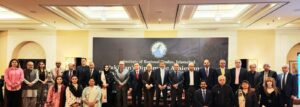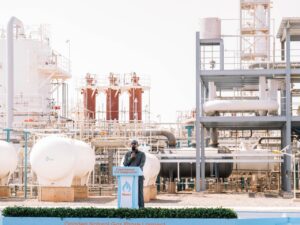Water is life. Today, the value and importance of water, as well as the demand for this vital resource, are steadily increasing worldwide. Experts explain this by factors such as climate change, the shrinking of ancient glaciers, industrial growth, population increase, and the resulting rise in food demand.
Uzbekistan is actively promoting important climate initiatives aimed at uniting the region in the fight against climate change. These initiatives of President Shavkat Mirziyoyev of Uzbekistan are consistently supported by the countries of the region.
In particular, at the Fifth Consultative Meeting of the Heads of State of Central Asia, held on 14 September 2023, Uzbekistan announced the initiative to develop a Regional Strategy on Climate Change Adaptation.
Furthermore, in his address at the 78th session of the United Nations General Assembly on 19 September 2023, the Head of State of Uzbekistan proposed the adoption of the resolution entitled “Central Asia Facing Global Climate Challenges: Solidarity for Common Prosperity.”
This initiative is primarily aimed at addressing the threats posed by global climate change in Central Asia and represents an important step towards strengthening both regional and international cooperation. Based on the principles of solidarity, the initiative underscores the necessity for Central Asian countries to act jointly in tackling such pressing challenges as desertification and water security, which have a direct impact on sustainable development and the well-being of people across the region.
On April 4, 2025, an International Climate Forum was held in Samarkand, where pressing climate challenges facing Central Asia were discussed, and issues of environmental sustainability, “green” economic development, and regional cooperation in combating climate change were addressed. The countries of the region unanimously approved the Strategy for Climate Change Adaptation in Central Asia.
All the countries of Central Asia, located within the Amu Darya and Syr Darya river basins, are closely interconnected through their waterways and water sources. In today’s context, water has become one of the most crucial factors in ensuring peace and prosperity for the peoples of Central Asia.
According to experts, under conditions of water scarcity, the transition to water-saving technologies is considered the most effective solution to the problem. There are specific reasons why specialists are currently focusing on the introduction of water-saving technologies. This approach does not place a heavy burden on the state budget, as it is mainly implemented at the expense of water users’ own funds. It is attractive not only because it saves water, but also because it reduces costs for mineral fertilizers, fuel and lubricants, and labor, while at the same time increasing crop yields.
Currently, Uzbekistan is taking a leading role among the Central Asian countries in reducing water scarcity by introducing water-saving technologies and expanding the use of modern technologies in water management.
In his address at the 78th Session of the UN General Assembly, the President of our country, Shavkat Mirziyoyev, also proposed the creation of a platform for water-saving technologies in Central Asia. He emphasized this issue once again in his speech at the Samarkand International Climate Forum on April 4, 2025.
“We are lining irrigation systems with concrete to save water. We have established an industrial base for the production of water-saving technologies and introduced such technologies on almost half of the irrigated lands (which is nearly two million hectares). As a result of these measures, last year we managed to save 8 billion cubic meters of water,” said the President.
At the same time, the head of our state is also putting forward a number of initiatives within domestic policy to address water-related challenges.
The Concept for the Development of the Water Sector of the Republic of Uzbekistan for 2020-2030 and the “Uzbekistan — 2030” Strategy set ambitious goals to improve the efficiency of water resource use.
In order to ensure the consistent implementation of these tasks and achieve the main target indicators, on 15 August 2025, the Program for the Development of Water Resources Management and the Irrigation Sector of the Republic of Uzbekistan for 2025–2028 was approved.
As a result of fulfilling the tasks set in this program:
– the share of main canals with concrete lining will increase from 39% to 47%, and the total length of these lined main canals will reach 13.5 thousand kilometers;
– the efficiency coefficient of irrigation systems and networks will increase from 0.67 to 0.75;
– through the implementation of land reclamation measures, the total area of salinized lands will be reduced from 1,898 thousand hectares to 1,732 thousand hectares, including a decrease in moderately and highly salinized lands from 578 thousand hectares to 460 thousand hectares;
– As a result of the measures taken, 10 billion cubic meters of water will be saved in the country this year, 12 billion cubic meters in 2026, 13 billion cubic meters in 2027, and 14 billion cubic meters in 2028.
The program aims to expand the area covered by water-saving technologies from 2.1 million hectares to 3.5 million hectares by 2028, including an increase in the area using drip irrigation technology from 560 thousand hectares to 853 thousand hectares.
As of 1 September of this year, water-saving technologies have been introduced on a total of 2.6 million hectares across the country, bringing their overall share to 60% of all irrigated lands.
By contrast, before 2017, the total area under water-saving technologies was only 28 thousand hectares, or about 1% of irrigated lands. Between 2017 and 2025, the following technologies were introduced:
– 664.3 thousand hectares under drip irrigation;
– 121.3 thousand hectares under sprinkler irrigation;
– 73 thousand hectares under discrete irrigation;
– 106.4 thousand hectares under other types of irrigation technologies.
In addition, 1.6 million hectares of land were leveled using laser equipment.
It is no secret that equipment and components for water-saving irrigation technologies were mainly imported from foreign countries. Until 2019, only three enterprises in the country produced polyethylene pipes and drip hoses, and the localization level was only 10% (with 90% imported), while their annual production capacity covered just 5.5 thousand hectares.
At that time, farms had to pay 100% of the cost in advance to implement drip irrigation systems and then wait 70–80 days for the technology to be delivered.
Today, however, the number of manufacturing enterprises has reached 60, the localization level has increased to 80%, and the annual production capacity has grown to 250–300 thousand hectares. Specifically:
– 44 enterprises produce drip hoses, various types of polyethylene pipes, and fittings;
– 10 enterprises produce filtration devices and pump units;
– 6 enterprises produce geomembrane and geotextile products.
Thanks to the initiative of the President of Uzbekistan, a target has been set to fully introduce water-saving technologies on all agricultural lands by 2030 — and the country has sufficient capacity to achieve this goal.
Uzbekistan is a country located in an arid region, far from oceans and large seas. According to forecasts, due to the impact of global climate change, water resources in the region will continue to decline, while demand for water will keep increasing as a result of population growth and industrial development.
In such conditions, the initiatives put forward by the President of Uzbekistan to ensure the security and prosperity of the region are of crucial importance, and their effectiveness is being confirmed by real-life results.



